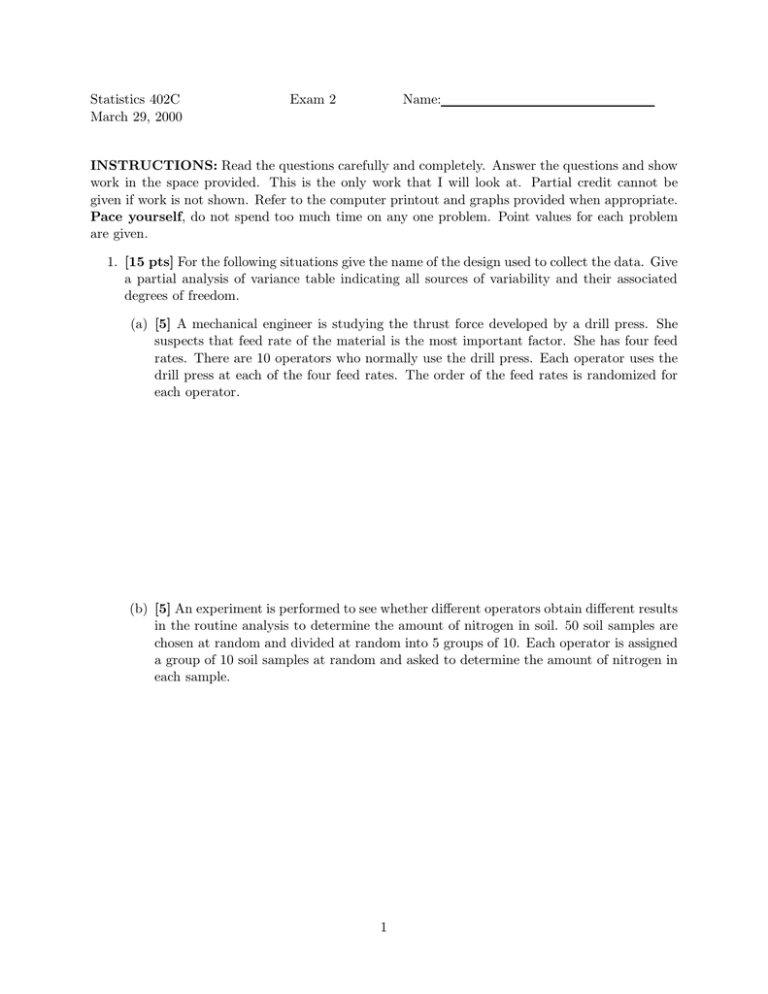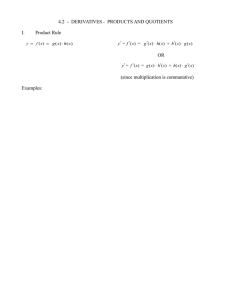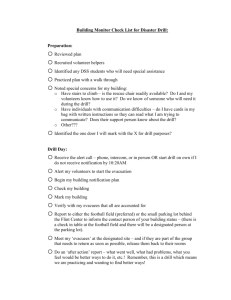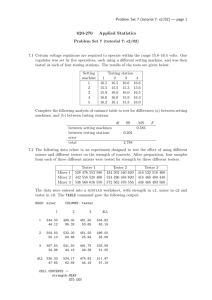Statistics 402C Exam 2 Name: March 29, 2000
advertisement

Statistics 402C March 29, 2000 Exam 2 Name: INSTRUCTIONS: Read the questions carefully and completely. Answer the questions and show work in the space provided. This is the only work that I will look at. Partial credit cannot be given if work is not shown. Refer to the computer printout and graphs provided when appropriate. Pace yourself, do not spend too much time on any one problem. Point values for each problem are given. 1. [15 pts] For the following situations give the name of the design used to collect the data. Give a partial analysis of variance table indicating all sources of variability and their associated degrees of freedom. (a) [5] A mechanical engineer is studying the thrust force developed by a drill press. She suspects that feed rate of the material is the most important factor. She has four feed rates. There are 10 operators who normally use the drill press. Each operator uses the drill press at each of the four feed rates. The order of the feed rates is randomized for each operator. (b) [5] An experiment is performed to see whether different operators obtain different results in the routine analysis to determine the amount of nitrogen in soil. 50 soil samples are chosen at random and divided at random into 5 groups of 10. Each operator is assigned a group of 10 soil samples at random and asked to determine the amount of nitrogen in each sample. 1 (c) [5] Similar to the experiment in (a) the thrust force of drill presses is of interest. This time the engineer is interested in both drill speed and feed rate. The engineer has 10 drill presses, chosen at random, to work with. Five of the drill presses are assigned at random to run at the high speed. The other five are run at the low speed. For each drill press each of the 4 feed rates is run in a random order. 2. [25 pts] An experiment is performed to evaluate the effect of various gasoline additives on the amount of nitrogen oxides in automobile emissions. Since different cars may naturally produce different amounts and drivers may affect the amount of nitrogen oxides in the emissions, both car and driver are treated as nuisance variables. In the experiment, each driver is to drive each car using one of the additives. The experiment is designed as a Latin Square. Below are the data. SAS output is also included. I D R I V E R II III IV Mean A D B C 1 B 21 23 15 2 Car D 26 C 26 D 13 A A C B 3 C 20 20 16 B A D 4 Mean 25 27 16 17 15 20 20 19 20 19 22 2 23 24 15 18 20 Class DRIVER CAR ADDITIVE Levels 4 4 4 Values I II III IV 1 2 3 4 A B C D Number of observations in data set = 16 Dependent Variable: OXIDE Source DF Sum of Squares Mean Square F Value Pr > F Model 9 280.000000 31.111111 11.67 0.0037 Error 6 16.000000 2.666667 15 296.000000 R-Square 0.945946 C.V. 8.164966 Root MSE 1.63299 DF Type I SS Mean Square F Value Pr > F 3 3 3 216.000000 24.000000 40.000000 72.000000 8.000000 13.333333 27.00 3.00 5.00 0.0007 0.1170 0.0452 Corrected Total Source DRIVER CAR ADDITIVE OXIDE Mean 20.0000 T tests (LSD) for variable: OXIDE NOTE: This test controls the type I comparisonwise error rate not the experimentwise error rate. Alpha= 0.05 df= 6 MSE= 2.666667 Critical Value of T= 2.45 Least Significant Difference= 2.8255 Means with the same letter are not significantly different. T Grouping Mean N ADDITIVE A A A 22.000 4 B 21.000 4 C 19.000 4 D 18.000 4 A B B B C C C 3 (a) [5] Are there statistically significant differences among the four additives in terms of average nitrogen oxide levels? Report the appropriate F value and P-value, and explain how these support your answer. (b) [5] What is the value of the Least Significant Difference (LSD)? Using this LSD is there a significant difference between additive A and additive B? (c) [15] Although this was designed as a Latin Square, there was some confusion on the part of the motor pool supplying the cars. Instead of using only 4 cars, 16 cars were used and these were completely randomized. Therefore, the only nuisance factor accounted for in the design is the driver. Construct an appropriate ANOVA table for this design and analysis. Answer the questions in (a) and (b) for this design and analysis. 4 3. [30 pts] In order to increase the strength, refine the grain and homogenize the structure of steel, steel is heated above a critical temperature, soaked and then air cooled. An experiment is performed to determine the effect of temperature and heat treatment time on the strength of steel. Two temperatures and three times are selected. The experiment is performed by heating the oven to a randomly selected temperature and inserting 3 specimens. After 10 minutes one specimen is chosen at random and removed, after 20 minutes a second specimen is chosen at random and removed, and after 30 minutes the final specimen is removed. Then the temperature is reset and the process is repeated. Each temperature is replicated 4 times in a completely random order. Below are the data arising from this split plot design and output from SAS. Run gives the randomized order of the Temperature settings. 1500 F Temperature 1600 F Time 10 20 30 Run Time 10 20 30 3 52 54 61 7 89 91 62 8 50 52 59 2 72 80 69 1 58 64 71 4 73 81 69 6 48 54 59 5 88 92 64 Run (a) [2] What is the whole plot factor? (b) [2] What is the sub plot factor? (c) [6] Are the two temperatures significantly different in terms of mean strength? Report the appropriate F- and P- values to support your answer. 5 Class Level Information Class Levels Values TEMP 2 1500 1600 RUN 8 1 2 3 4 5 6 7 8 TIME 3 10 20 30 Number of observations in data set = 24 Dependent Variable: STRENGTH Source DF Sum of Squares Model 11 4022.66667 365.69697 Error 12 278.66667 23.22222 Corrected Total 23 4301.33333 R-Square C.V. Root MSE STRENGTH Mean 0.935214 7.174607 4.81894 67.1667 DF Anova SS Mean Square F Value Pr > F 1 6 2 2 2562.66667 381.33333 192.33333 886.33333 2562.66667 63.55556 96.16667 443.16667 110.35 2.74 4.14 19.08 0.0001 0.0650 0.0429 0.0002 Source TEMP RUN(TEMP) TIME TEMP*TIME Level of TEMP 1500 1600 N N 10 20 30 8 8 8 F Value Pr > F 15.75 0.0001 -----------STRENGTH---------Mean SD 12 12 Level of TIME Mean Square 56.8333333 77.5000000 6.5203644 10.7492072 -----------STRENGTH---------Mean SD 66.2500000 71.0000000 64.2500000 6 16.6368781 16.9452901 4.8032727 (d) [5] Are there significant differences among the times? Report the appropriate F- and Pvalues to support your answer? (e) [5] Compute the LSD for comparing means strengths for the three times. What, if any, times are significantly different? (f) [5] Is there a significant interaction between temperature and time? Report the appropriate F- and P- values to support your answer. (g) [5] On the next page is an interaction plot. Interpret this plot and indicate what it tells you about the combined effects of time and temperature. 7 8


